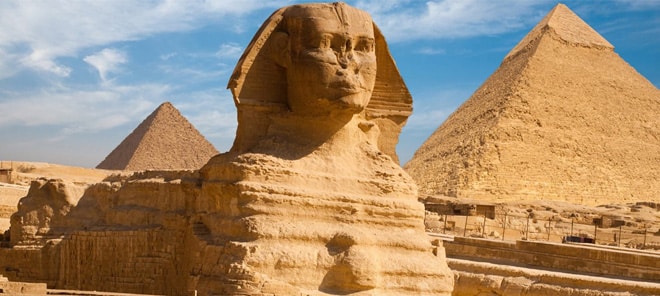Built during a time when Egypt was one of the richest and most powerful civilizations in the world, the pyramids—especially the Great Pyramids of Giza—are some of the most magnificent man-made structures in history. Their massive scale reflects the unique role that the pharaoh, or king, played in ancient Egyptian society. Though pyramids were built from the beginning of the Old Kingdom to the close of the Ptolemaic period in the fourth century A.D., the peak of pyramid building began with the late third dynasty and continued until roughly the sixth (c. 2325 B.C.). More than 4,000 years later, the Egyptian pyramids still retain much of their majesty, providing a glimpse into the country’s rich and glorious past.
THE EARLY PYRAMIDS
From the beginning of the Dynastic Era (2950 B.C.), royal tombs were carved into rock and covered with flat-roofed rectangular structures known as “mastabas,” which were precursors to the pyramids. The oldest known pyramid in Egypt was built around 2630 B.C. at Saqqara, for the third dynasty’s King Djoser. Known as the Step Pyramid, it began as a traditional mastaba but grew into something much more ambitious. As the story goes, the pyramid’s architect was Imhotep, a priest and healer who some 1,400 years later would be deified as the patron saint of scribes and physicians. Over the course of Djoser’s nearly 20-year reign, pyramid builders assembled six stepped layers of stone (as opposed to mud-brick, like most earlier tombs) that eventually reached a height of 204 feet (62 meters); it was the tallest building of its time. The Step Pyramid was surrounded by a complex of courtyards, temples and shrines, where Djoser would enjoy his afterlife.
THE PYRAMIDS TODAY
Tomb robbers and other vandals in both ancient and modern times removed most of the bodies and funeral goods from Egypt’s pyramids and plundered their exteriors as well. Stripped of most of their smooth white limestone coverings, the Great Pyramids no longer reach their original heights; Khufu’s, for example, measures only 451 feet high. Nonetheless, millions of people continue to visit the pyramids each year, drawn by their towering grandeur and the enduring allure of Egypt’s rich and glorious past.
